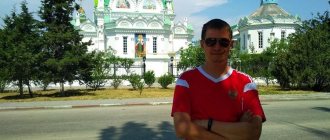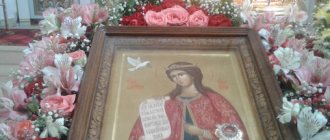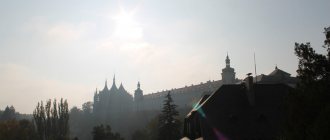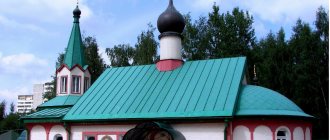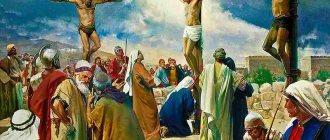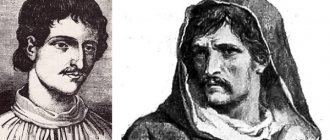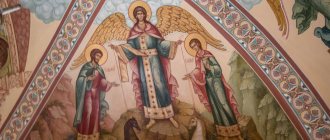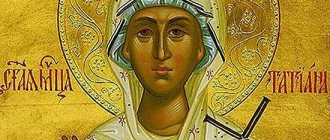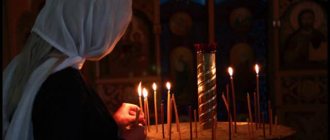The Church of the Holy Great Martyr Catherine is a functioning Orthodox shrine of modern times in Rome, subordinate to the Moscow Patriarchate. Located on the territory of the residence of the Embassy of the Russian Federation.
The Church of Catherine is interesting by the very fact of its existence - the center of the Russian Orthodox faith in the heart of the papal Catholic diocese. Confessional tensions are softened by the personality of the great martyr herself, because she was revered by Christians in an era when Catholics and Orthodox Christians were united.
Church of the Great Martyr Catherine
Russian Orthodox Church in honor of St. Catherine's is the main church of the Patriarchal parishes in Italy. It is located on the territory of Villa Abamelek, which houses the Russian embassy. The building rises on a hill overlooking the Cathedral of St. Petra. In the temple, pilgrims can venerate the relics of the Great Martyr Catherine, the first Christians and the holy Equal-to-the-Apostles Queen Helen. There is also an ark with a piece of the cross on which, according to legend, Jesus was crucified.
The idea of construction belongs to Archimandrite Clement, rector of the Russian Embassy Orthodox Church in Rome at the end of the 19th century. The temple was built with donations from Russian princes, merchants, and manufacturers. Nicholas II transferred 10 thousand rubles for construction. By 1917, a sufficient amount of money had been collected for the construction of the temple. However, due to the revolution in the Russian Empire, work never began.
To the project at the end of the twentieth century. Metropolitan Kirill of Smolensk and Kaliningrad returned (today’s Patriarch Kirill). The construction of the temple was associated with a large number of obstacles. Money for construction was collected again. In addition, it was necessary to obtain permission: the construction of an Orthodox church in the capital of Catholicism was not allowed. To legalize the issuance of the permit, the government amended the legislation of the region.
Construction work began in 2001 and lasted 8 years. During the construction process, it became necessary to demolish the hill on which the work was being carried out due to the high domes of the Orthodox church. According to the law, no religious building in the Italian capital can be higher than St. Peter's Basilica. In the spring of 2009, the consecration of the temple took place.
Architecture and interior decoration
The chief architect was Andrei Obolensky, whose team was able to create an ideal harmony between the Orthodox tradition and Roman architectonics. The territory is located on a hill, which predetermined the architectural composition of the temple, starting from the foot of the Janiculum hill (Gianicolo) and ending at its top. In order not to be dissonant with Roman architecture, the main church is built in the form of a tent, and all the walls are lined with travertine, traditional for the original Roman architecture.
The lower aisle of the church complex is marked with a faience iconostasis in honor of Constantine and Helena. And the main part, the so-called upper church, has a main marble iconostasis. The latter’s project was created and mostly implemented by Alexander Soldatov, a teacher at the Moscow Icon Painting School. Being unconventional for the Russian church, the iconostasis consists of only two rows. The lower one is made in a modest manner without frills and inappropriate shine using fresco technique. The top row is already made in the usual medallion technique with gilding and rich decoration, paying tribute to Russian Orthodox traditionalism.
In 2012, painting began on the inside of the temple, which represents pictures of the path of the Great Martyr Catherine from birth to ascension. Within the walls of the temple there are a number of Orthodox relics that attract hundreds of parishioners here every day, both on their own initiative and as part of pilgrimage tours of Orthodox Christians from Russia and all over the world.
Interesting Facts
- To obtain a license to build a temple, it was necessary to make changes to some laws of the Lazio region , which previously prohibited any development in this corner of Rome.
- At the height of construction, local architectural authorities limited the height of the church, since no building in Rome could be taller than St. Peter's Basilica di San Pietro. The architect did not abandon his plan and solved the problem by “sinking” the building into the hill.
Church of St. Nicholas the Wonderworker
The Orthodox Church in honor of St. Nicholas the Wonderworker is the oldest Russian Orthodox parish in Italy. The building was supposed to have a cruciform shape. However, due to a lack of land, the architect's plans could not be fully realized. The church was rebuilt: arches were built, an altar was added, and internal partitions were eliminated. Among the shrines of the church:
- an icon of Princess Olga painted by the Greek Princess Mary;
- the cross located in the altar is a gift from the Greek Prince Christopher;
- Iveron Icon of the Mother of God, painted in memory of Tsar Alexander III.
The house church of St. Nicholas the Wonderworker appeared in Rome in the early 1820s. However, she did not have a permanent address, moving for 100 years from one premises to another. In 1867, services were suspended for several years due to worsening relations with the Pope. Orthodox Christians living in the Italian capital traveled to Naples for services.
The first attempts to build a separate building for an Orthodox church in Rome began at the end of the 19th century. Donations for the construction were made by nobles, rich townspeople and the poor. However, for various reasons, construction was constantly delayed.
In the early 1930s. The parish moved to a mansion, which was bequeathed to it by the owner of the house, Princess M.A. Chernysheva, an emigrant from Russia. Among those who made donations for the improvement of the temple were Russian immigrant nobles, the embassies of Bulgaria and Serbia, and the Italian Queen Helena of Savoy.
During and after World War II, the parish provided support to refugees from other countries. At the end of the twentieth century. The community increased due to immigrants from Russia and Italians who converted to Orthodoxy.
The Birth of Christianity
The Great Roman Empire at one time borrowed a religious model from the civilization of the Ancient Greeks. A whole galaxy of deities, their assistants and offspring migrated from ancient Greece straight to Roman Olympus, changing only their names.
After 8 centuries, philosophers and nobles lost faith in their gods. By the end of the 1st century AD, Christianity arose in the depths of the prosperous empire.
Representatives of the Jewish people presented the multinational state with a new religion based on faith in one God. Gradually, Christianity began to spread among other peoples of the empire.
By the 3rd century, the new faith that had captured the minds of Caesar's subjects was prohibited. However, already in 313, Constantine the Great signed the Edict of Milan, proclaiming tolerance of the Christian faith. Soon the first stone of the Lateran Basilica was laid - the oldest Christian temple that has survived to this day.
Terms
By the end of the 4th century, paganism was forgotten, and Christianity became the official religion.
Temples and sanctuaries of ancient deities were urgently destroyed or rebuilt to suit the needs of the new faith. Continuing centuries-old traditions, church ministers received basilicas (ancient Greek: βασιλική) - “royal houses” at their disposal. This type of structure is characterized by the shape of an elongated rectangle with an odd number of naves (usually 3, less often 5). Another distinctive feature of the basilica is the absence of a clearly defined dome. In addition to being a purely architectural term, “basilica” is also a special title in the Catholic Church. The oldest and most significant churches and cathedrals for Catholics are honored to receive from the Pope the title of basilica of one of five degrees (archbasilica, great, papal, patriarchal and minor).
Since the emergence of Christianity, there has been an unspoken division into Western and Eastern branches. The first was the Catholic Church with the primacy of the Popes, and the second was Orthodoxy with the patriarchate in Constantinople. Centuries-old disagreements between the Latin and Orthodox churches on a number of church dogmas led to the fact that in 1054 Pope Leo IX and Patriarch Michael Cerularius betrayed each other with mutual anathema.
The Great Schism not only forever divided Christians into Orthodox and Catholics, but also influenced all areas, including the appearance of church buildings. Thus, the image of basilicas began to be inherited to a greater extent by Catholic architecture. In the Middle Ages, the Romanesque style evolved into Gothic, and later into Baroque and Rococo. In the general sense, a “temple” (Orthodox chormъ) is a house in which there is an altar and church rituals are performed.
Orthodox architecture acquired its own model of the church - the “cathedral” (Old Slavic collection). Derived from the Old Slavonic “gathering,” that is, a place for gathering, a cathedral is the main church of a settlement, where services and rituals take place. It is the cathedrals that are characterized by the Byzantine domed style of construction and the pronounced cruciform shape of the buildings.
What else should an Orthodox pilgrim visit in Rome?
Most churches in Rome, such as St. Peter's Basilica, are Catholic. Orthodox Christians are not prohibited from visiting Roman churches. Also in the Italian capital there are places sacred to all followers of Christ.
Coliseum
For most Romans, the Colosseum was their favorite place of entertainment. The arena hosted gladiator fights and fights between wild animals and people. After the spread of Christianity among the Romans, the first followers of Jesus were given to animals to be torn to pieces. Christians posed a danger to the dominant political system and religion. In addition, many Romans believed that the gods were sending trials to their hometown for the appearance of apostates in society.
In the arena of the Colosseum, the Hieromartyr Ignatius the God-Bearer, Saint Tatiana, the Hieromartyr Eleutherius and other Christians recognized as saints by the church died. Bloody reprisals against representatives of the new religion were prohibited only under Emperor Constantine. Today, Catholics and Orthodox Christians come to worship the place where fighters for the faith ended their earthly journey.
Mamertine prison
The dungeon is located at the foot of the Capitoline Hill. Here the disciples of Christ Paul and Peter spent their last days before their execution. On the first floor of the dungeon, the pillars to which the apostles were chained and the sacred spring were preserved. According to legend, the sacred waters were extracted from the earth by Peter. Prisoners and guards who believed in one God after the sermons of the apostles were baptized in them.
During the persecution of Emperor Valerius, many Christian martyrs were imprisoned in the Mamertine prison: Deacon Agapit, Adrian, his wife Pavlina and their children, Presbyter Euseus, etc.
Catacombs
In the catacombs, the first Christians held services and buried their dead coreligionists. In the 5th century They stopped burying people in the dungeon. However, the site was considered sacred due to the fact that Christian martyrs were buried there. After the establishment of Christianity, the remains of believers began to be transferred to city churches. The catacombs ceased to be a place of worship. They were forgotten for several centuries.
At the end of the 16th century. exploration of underground galleries began. Today, pilgrims can visit the catacombs of Priscilla, Domitilla and St. Callistus.
Saint Catherine
During her lifetime, Catherine was a noble resident of Alexandria, received a decent education, and at the beginning of the 4th century. accepted Christ. Wanting to open the eyes of her contemporary to paganism, Catherine entered the imperial palace and participated in a theological debate with the court sages, as a result of which they all believed in Christ.
Such a daring act led to the girl’s imprisonment and quick execution, but before that, with her passionate speeches and unshakable faith, she converted the emperor’s wife and part of his army to Christianity - all of them were also executed.
Three centuries after these bloody events, Catherine’s followers found her incorrupt remains on Mount Sinai and transferred them to a new temple.
History of the Russian Orthodox community in Rome
Honorary rector of the St. Nicholas Church in Rome, Archpriest Mikhail Osorgin with parishioners, 2005
History of the Russian Orthodox community in Rome
The Russian Church of St. Nicholas the Wonderworker in Rome is the oldest Russian church in Italy. On the recommendation of the Board of the Ministry of Foreign Affairs, on October 6, 1803, Emperor Alexander I signed a decree establishing a “Greek-Russian Church” at the Roman embassy mission. Initially, it was supposed to be consecrated in the name of the holy Apostles Peter and Paul - probably as a sign of respect for Rome, the city where the relics of the supreme Apostles rest. The war with Napoleon distracted Russia from the church project: the church at the mission was built only twenty years after the signing of the Imperial Decree, in 1823. The single-altar church in the name of St. Nicholas the Wonderworker was placed in the embassy house at Via del Corso, 518. Subsequently, for a whole century, the church wandered along with the Russian embassy from one house to another. Like all other foreign churches, the Roman one was included in the St. Petersburg diocese, but in many ways, primarily financially, it depended on the Ministry of Foreign Affairs and was called embassy. During the 19th century, the church had several rectors; some of them died here and were buried in Rome. The initiative to build a Russian church belonged to Archimandrite Kliment (Vernikovsky), who was rector in 1897–1902. The idea of building a church in the Roman Catholic “throne city” had long been discussed by that time. Archimandrite Clement (later Bishop of Vinnitsa, † 1909) from the very beginning of his abbot declared “the need to have an Orthodox church that meets the dignity of Orthodoxy and the greatness of the Fatherland.” Already in 1898, fundraising began, which in 1900 was officially authorized by Emperor Nicholas II, who made a royal “contribution” of 10 thousand rubles. To raise funds, Archimandrite Clement even traveled to Moscow, where he managed to receive money from the Grand Dukes Sergei Alexandrovich and Mikhail Nikolaevich, Moscow manufacturers and Siberian gold miners. A total of 265 thousand Italian lire were collected. In 1912–1914, Archimandrite Dionysius (Valedinsky) served here, who published “A Companion to the Russian Orthodox Pilgrim in Rome” (1912) - a wonderful book that describes in detail the location of all common Christian shrines kept in the “eternal city.” (In 2002, this book was republished again by the St. Nicholas parish.) Under him, fundraising for the construction of a temple in Rome continued. In the fall of 1913, Emperor Nicholas II authorized the collection of donations throughout Russia. In the summer of 1914, the State Bank opened a special account in St. Petersburg. From 1914 to 1916, the rector of the church was Archimandrite Philip (Gumilevsky), who was killed in Russia in 1936. In 1915, he formed a new construction committee, headed by Prince S. S. Abamelek-Lazarev. The prince imposed another architect on the committee - Vincenzo Moraldi. The Italian's project was subjected to examination and serious criticism by the architect V. A. Subbotin, who then supervised church construction in the city of Bari. From 1916, for almost half a century (more precisely, forty-seven years), Archimandrite Simeon labored as rector of the only Orthodox parish in Rome (Narbekov, † 1969). He, like the previous rectors of the Russian church, is buried in the Roman non-Catholic cemetery for foreigners Testaccio. Thanks to the tireless and selfless labors of Father Simeon, the Russian Orthodox Church was established in the house of His Serene Highness Princess Maria Alexandrovna Chernysheva (1847–1919), who in 1897 bequeathed her Roman house at Via Palestro, 71 (“Palazzo Chernyshev”) to the Russian Orthodox parish. Here the church in the name of St. Nicholas the Wonderworker began to operate. “April 25, 1932 was the most significant, joyful and bright day in the life of the Russian Orthodox parish in Rome and all Orthodox believers living here. Your tireless labors, crowned with complete success, led to the creation of this Orthodox church of ours, and on this day it was solemnly consecrated and under these arches the Divine Liturgy was served for the first time by you. The creation of every Orthodox church - large or small - is always a joyful, bright event in church life, but the creation of our church was a particularly significant and joyful event due to the fact that it was created in one of the main centers of Christianity, in Rome, inextricably linked with memories about the first centuries of Christianity, with the thought of the chief apostles Peter and Paul and so many holy martyrs for Christ, who spread the light of Christ’s teaching throughout the world. For a long time, every Orthodox Christian felt the need to have his own Orthodox church in Rome. The tsarist government also became concerned with purchasing land for this purpose, but the crushing storm of a merciless revolution that broke out over our homeland prevented the fulfillment of this intention. But now, during the years of great suffering in Russia, during the years of our dispersion, this legitimate aspiration of ours was nevertheless destined to be realized,” said the address sent by parishioners to Archimandrite Simeon. “When in 1931 Metropolitan Eulogius (Georgievsky, † 1946) headed the temporary Russian Exarchate in Western Europe, which was under the jurisdiction of the Patriarchate of Constantinople, all the parishes that depended on him remained faithful to him. However, the Roman parish with its clergy already in 1927 chose the jurisdiction of the Russian Orthodox Church Outside of Russia,” writes modern researcher A. Nivier. Another significant event in the life of the Russian Orthodox community in Rome is associated with the name of Archimandrite Simeon. On November 1/14, 1929, the Italian monarch signed a decree on the establishment of “ente morale” under the Russian Orthodox Church, which meant that the Russian parish received the rights of a legal entity and allowed it to take legal possession of the house of Princess M. A. Chernysheva. The address of the parishioners of the St. Nicholas Church rightly spoke about the creation of this Russian Orthodox Church. Archimandrite Simeon left a bright memory of himself in the hearts of the parishioners of the Roman St. Nicholas Church. In 1943, some sermons of this “Chrysostom of the Russian Church Abroad” were published here, as the later publisher of unpublished sermons in the Munich almanac “Veche” (2000. No. 65) called him. His successor from the mid-1950s was Archimandrite Callistus (Podzolov). He was born on September 20, 1895. From 1935 to 1945 he was rector of the parish in San Remo. From 1945 to 1961, he served as assistant rector of St. Nicholas parish in Rome, co-serving Archimandrite Simeon (Narbekov). He was elevated to the rank of abbot in 1946, and to the rank of archimandrite in 1949. When Archimandrite Simeon retired in the late 1940s, Archimandrite Callistus actually served as rector of the parish in Rome. From 1946 to 1961 he was dean of the Russian parishes of the Russian Orthodox Church Outside of Russia and vice-chairman of the Roman Committee of the Red Cross. Hegumen Callistus regularly performed divine services in the camps of “displaced persons” (“di-pi”), in Trieste, Latino, Naples and near Turin (Villa Olanda) and distributed benefits and donations among interned compatriots. He died on October 21, 1963 and was buried according to his will in a common Russian grave in the non-Catholic cemetery of Testaccio in Rome. In the 1960s, the community was subordinate to Archbishop Anthony of Geneva (Bartoshevich, † 1993). In 1966, Archpriest Viktor Ilyenko was appointed to St. Nicholas parish. Father Victor came from a simple peasant family, was born in Primorye and received his initial theological education at the Irkutsk Seminary, then entered the Moscow Theological Academy. During the Civil War he fought in the ranks of the Volunteer Army. After the defeat of the White movement in 1920, he left Russia. In 1921, for three months he served as psalmist and regent at the Russian Church of St. Nicholas in Rome. Then he moved to the south of France. In 1929 he was ordained a priest and served as pastor of parishes in Tarascon, Brussels and Holland. While in Brussels, he published seventy-nine issues of the Parish Leaflet. From 1953 to 1966 he was rector of the Church of the Transfiguration in Los Angeles (USA). For almost twenty years, until 1984 inclusive, Father Victor was rector of St. Nicholas parish in Rome. In 1984, he left the state due to old age and returned to the United States. Died in Los Angeles in 1989. Archpriest Viktor Ilyenko was a prominent spiritual writer and a wonderful preacher. In 1984, Priest Mikhail Maklakov was appointed rector of the parish. From the very beginning, Father Mikhail took a tough anti-ecumenical position, including in relation to the Catholic environment. Due to this, and also due to some other reasons, he came into conflict with the parish and was forced to leave Rome. In 1985, St. Nicholas parish came under the omophorion of the Archdiocese of Orthodox Russian Churches in Western Europe. In February 1987, Archpriest Mikhail Osorgin became rector. Father Mikhail comes from the old noble family of the Osorgins, to which the holy righteous Juliana Lazarevskaya belonged. Born in 1929 in Moscow, he emigrated to Paris in 1931 with his mother, née Princess Golitsyna.
His father Georgy Mikhailovich Osorgin, an imperial cavalry guard, was shot on Solovki in 1929. Brought up among the Russian emigration, Father Mikhail adopted the best spiritual traditions of the Paris Archdiocese. His childhood formation was greatly influenced by his grandfather, also Archpriest Mikhail Osorgin, former imperial governor in Kaluga and Grodno. Then there were years of study at the St. Sergius Theological Institute, where fate brought him together with the best representatives of the Parisian theological school. His classmates were the future Patriarch of Antioch Ignatius, Protopresbyter Alexander Schmemann, Protopresbyter John Meyendorff. A new era in the life of the Russian parish in Rome is associated with the name of Father Michael. If by the beginning of the 1980s the Russian community in Rome consisted mainly of old emigration, then by the mid-1980s the number of parishioners began to grow rapidly. But the parish began to increase especially significantly since the mid-1990s, when Italy became one of the centers of new emigration. A fateful decision for the life of St. Nicholas parish and, in a broad sense, for the entire Russian Orthodox Church in diaspora, was made on October 26, 2000 at a meeting of members of “ente morale”. St. Nicholas parish returned to the bosom of the Mother Church, which was largely due to the conviction of Father Mikhail Osorgin that the future of Orthodoxy in Western Europe depends on the unification of all its branches under the omophorion of His Holiness the Patriarch of Moscow and All Rus'. In September 2004, Bishop Mark of Yegoryevsk was appointed rector of St. Nicholas Church. Thanks to him, a new page was opened in the life of the Russian Orthodox community in Rome. A graduate of Moscow Theological schools, a teacher at the Moscow Academy of Sciences and Sports, a candidate of theology, a monk of the Trinity-Sergius Lavra, then an assistant to the head of the Russian Spiritual Mission in Jerusalem and, finally, a deputy chairman of the Department for External Church Relations of the Moscow Patriarchate - he was able to put all his rich spiritual and pastoral experience to good use Roman parish. Large-scale restoration work has begun at St. Nicholas Parish. In particular, the external restoration of the church house was carried out, the interior of the church was restored, the concrete flooring of the church yard was completely covered, a second entrance was made to the premises of the church basement, thanks to which the parish was able to equip a church school for the children of parishioners. A large-scale pilgrimage program has been developed, including visits to all the holy places of Rome throughout the year, and pilgrimages to the pan-Christian shrines of the Italian Land (the city of Bari, the city of Amalfi) and to the Holy Land are also organized. In the new century, the clergy of St. Nicholas Church in Rome continues to care for all those striving for the Orthodox faith, giving them hope and helping them maintain mental fortitude in the difficult conditions of life in a foreign country.
Hieromonk Philip (Vasiltsev)
| MAGAZINE OF THE MOSCOW PATRIARCHY | 06-2006 |
Current state[edit]
If by the beginning of the 1980s. the Russian community in Rome consisted mainly of representatives of the “first wave” of emigration, then already from the mid-1980s, when the Italian capital became one of the transit points of “new emigrants” (former Soviet citizens looking for new opportunities in the West), the number of parishioners began to increase rapidly. Many visitors received Holy Baptism here, got married, baptized their children, while remaining permanent or temporary residence in Italy, they maintained contact with the Orthodox Church, becoming parishioners of the Church of St. Nicholas on Via Palestro.
Catholic churches of Rome
Since the Catholic faith was born and strengthened in Rome (Latin Catholicismus - “universal”, “one”), most of the churches in the city are Catholic churches and cathedrals. The oldest and most titled churches in Rome are located on the territory of the capital and city-state of the Vatican. The pontificate spared no expense on their decoration, restoration and maintenance, so the capital’s churches are a breathtaking sight.
Lateran Basilica
The main cathedral of Rome - the Basilica of San Giovanni in Laterano (Basilica di San Giovanni in Laterano) was founded in the 4th century. One of the first Christian churches is the “archbasilica”, in which the papal throne and pulpit are located. In its external and internal design, this cathedral has retained many elements of the early Christian era. The medieval design of the facade carefully hides the ancient mosaics from precipitation and direct sunlight.
The interior of San Giovanni in Laterano is replete with paintings on the theme of Genesis, as well as the acts of the apostles Paul and Peter. Inside the temple are richly decorated chapels containing the tombs of pontiffs and famous citizens of Rome.
Address: Piazza di San Giovanni in Laterano, 4
Lateran Palace
The monastery of the pontiffs, located next to the Lateran Basilica, was built in the 4th century. Until the beginning of the 14th century, the palazzo invariably fulfilled its role until the pontificate was moved to French Avignon. After several reconstructions, it has a typical appearance for Italian Renaissance palaces. In modern times, the Lateran Palace houses one of the Vatican museums.
The Catholic Holy of Holies or Chapel Sancta Sanctorum (lat. Sancta Sanctorum) evokes special reverence among visitors. The chapel dedicated to St. Lawrence contains the tombs of the popes. Many relics were moved from the Holy of Holies to the Lateran Basilica. Of the valuables remaining in the chapel, the miraculous 6th century icon with the face of Jesus is valued. Also preserved are frescoes from the 13th century and sacred gifts sent in the 8th century from Constantinople.
Address: Piazza San Giovanni in Laterano
Basilica of San Clemente
The Basilica of St. Clement is primarily interesting as a real monument of history and archeology. The foundation of the building was laid in the 1st century AD. consul Titus Flavius Clement, who was related to the Caesars. During the persecution of Christians, a noble Roman secretly sheltered adherents of the faith, including St. Peter. In the 4th century, the estate was turned into an ancient Christian temple. The modern façade of the church is a striking example of Romanesque architecture, characteristic of the 12th century.
Among the relics kept in the basilica, the following are especially revered: the relics of St. Clement, one of the first Christian bishops, and the hieromartyr Ignatius the God-Bearer. The ancient Catholic church is located near the Lateran Basilica and the Colosseum.
Address: Via Labicana, 95
Santa Maria Maggiore (Basilica di Santa Maria Maggiore)
Papal basilica, founded in the 5th century AD. on the Esquiline Hill in Rome. The Catholic Church is dedicated to the Holy Virgin Mary. The external style is a combination of strict Romanesque and more luxurious Rococo. A high bell tower rises above the church.
In the interior of Santa Maria Maggiore, the early Christian mosaics, the rich decoration of the naves, as well as the luxurious chapels in which pontiffs and famous Italians rest, make a great impression.
Address: Piazza di S. Maria Maggiore, 42
St. Peter's Basilica (Basilica di San Pietro)
St. Peter's Cathedral (Basilica di San Pietro) in the Vatican is one of the four patriarchal basilicas of the eternal city, has a respectable size and solemn decoration. Officially founded in the first half of the 17th century, the cathedral is located on the spot where, according to ancient legends, in the 1st century AD. Saint Peter was buried. Outstanding medieval architects had a hand in the creation of the grandiose temple: Donato Bramante, Raphael (Raffaello Santi), Gian Lorenzo Bernini (Giovanni Lorenzo Bernini) and Michelangelo (Michelangelo Buonarroti).
In front of the luxurious snow-white facade of the cathedral lies a vast circular area. On major church holidays, as well as on special occasions, ceremonies take place within the walls of the cathedral with the participation of the Pope. The cathedral and the square together can accommodate up to 460 thousand parishioners.
Address: Piazza San Pietro, Città del Vaticano
San Paolo fuori le Mura (Basilica di San Paolo fuori le Mura)
St. Paul's Cathedral, the Great Papal Basilica, by the standards of Emperor Aurelian (3rd century AD) is located outside the ancient walls of the Italian capital. The church was built by Constantine the Great on the site of the supposed burial place of St. Paul. The vast building is decorated with antique columns. Of great interest is the gallery filled with portraits of pontiffs.
Over the past centuries, the temple has been repeatedly looted and burned. The mosaics of the 5th century and some elements of interior decor have survived to this day. Much of the interior was recreated during a large-scale reconstruction in the 19th century. During excavations, an ancient stone tomb was discovered under the main altar, in which the relics of the Apostle Paul allegedly rest.
Address: Piazzale San Paolo, 1
Church of the Holy Name of Jesus (Il Gesu)
The main temple of the Jesuit order is dedicated to the name of the son of God, and therefore its short name sounds like the Church of the Gesu (Jesus). A small white building nestles comfortably in the historical center of Rome. The temple was built in the 16th century by the famous architect Giacomo della Porta, an adherent of pretentious mannerism.
Visitors are especially impressed by the painted ceilings of the nave and dome of the church. The characters from the Bible and holy scripture are made so skillfully that they look three-dimensional.
Address: Via degli Astalli, 16
San Carlo alle Quattro Fontane
The medieval church of St. Charles with 4 fountains, built by the architect Francesco Borromini for the canonization of Cardinal Carlo Borromeo.
The silhouette of the temple, as well as its external decoration, is filled with graceful lines and ornate flourishes of the Baroque style. The building is crowned with a high oval dome, decorated on the inside with stucco with a geometric pattern. The interior is dominated by white color and baroque stucco.
Interestingly, the Church of San Carlo is located near the street of four fountains (Via delle Quattro Fontane), decorated with 4 Renaissance fountains of the 16th century.
Address: Via del Quirinale, 23
Literally a hundred meters away at Via del Quirinale, 30 there is another unusual church of Sant'Andrea al Quirinale by Bernini.
Sant'Ivo alla Sapienza
The temple was built in the 17th century in order to be consecrated in honor of Saint Ivo of Brittany, patron of the Jesuit Order.
The author of the project was Borromini, who gave the building a magnificent Baroque design. The church has a hexagonal shape with rounded edges, unusual for Catholic churches. Sant'Ivo represents a single architectural ensemble with the arched arcade of the University of La Sapienza (Universita degli studi di Roma La Sapienza).
The interior of the church is characterized by Borromini's white color and exquisite decoration. The high dome of the temple is covered with intricate stucco.
Address: Corso del Rinascimento
Basilica Sant'Agnese in Agone
The church, consecrated in the name of St. Agnes of Rome, was built in the 17th century by Girolamo Rainaldi. Borromeo gave the final appearance to the temple, so the façade of the building combines mannerism and baroque. The interior of the temple is replete with marble bas-reliefs. The painted dome creates a special atmosphere. The sarcophagus of Pope Innocent X is kept in the chapel.
Basilica of St. Agnes stands on Piazza Navona, rich in other attractions of Rome.
Address: Piazza Navona / Via S. Maria dell'Anima 30/A
Santa Maria della Concezione dei Cappuccini
The 17th-century Catholic church, belonging to the Capuchin Order, is modest in size and simple in appearance.
Inside the church you can admire paintings by Caravaggio, Pietro da Cortona and Domenichino. The crypts of the Capuchin Church cause special awe among visitors. Six underground rooms contain decorations made from the remains of monks. About 4 thousand servants of God who died from the 16th to the 19th centuries were moved from the Roman cemetery to the crypt. The chilling decor of skulls and bones was performed by servants of the order.
Address: Via Vittorio Veneto, 27
Santi Apostoli
The Catholic Church, founded in the 6th century AD, originally worshiped the apostles James and Philip. Over the past centuries, the name of the church has changed to the Holy Apostles or 12 Apostles. The three-nave Romanesque basilica significantly updated its appearance in the 18th century. A student of the great Bernini, Carlo Fontana, transformed the modest temple into a majestic Baroque building.
The tombs of Pope Clement XIV by Cannova and Cardinal Pietro Riario stand out in the interior. And also the fresco by Domenico Muratori “The Martyrdom of St. Philip and Jacob."
Address: Piazza dei Santi Apostoli, 51
Santa Susanna (Chiesa di Santa Susanna alle Terme di Diocleziano)
The modest church was erected in the 5th century on the site of the martyrdom of Saint Susanna of Rome. The temple building was rebuilt several times. It is noteworthy that the current façade of the church is considered one of the first examples of the Baroque style. The inside of the church is richly decorated with decorative panels and sculptures. The main altar is decorated with paintings depicting St. Susanna.
At the moment, Santa Susanna is the main Catholic church for US citizens.
Address: Via 20 Settembre, 14
Castle of the Holy Angel (Castel Sant'Angelo)
Castel Sant'Angelo is an ancient historical monument with an intricate fate. A squat, rounded monument arose on the banks of the Tiber in the 2nd century AD. Emperor Hadrian planned to use the building as a family mausoleum. In the 6th century, the tomb acquired its current name, by the will of Pope Gregory I, who saw an angel descending to the dome of the mausoleum.
In the Middle Ages, the pontificate actively used the mausoleum for its needs, including for secret movement between the Vatican and Rome. By the 16th century, the castle was converted into a real fortress, in which Pope Clement VII hid from Spanish troops. Subsequently, the Castel Sant'Angelo became a dungeon for the defenders of the capital.
Currently, the monument has preserved part of the ancient buildings of the mausoleum, which were reconstructed by the Vatican in the 15th-16th centuries. Modern relics of the castle: ancient urns with the ashes of the Caesars, the Angel's courtyard (XV century), loggias, halls and apartments that belonged to the popes of the medieval era. Among other things, the castle terrace offers a magnificent view of the Eternal City.
Address: Lungotevere Castello, 50
Basilica of Maxentius and Constantine (Basilica di Massenzio di Costantino)
The Basilica of Maxentius or New Basilica was once the largest Christian temple in Rome. The idea of building a basilica in 312 was visited by Emperor Maxentius, who soon fell at the hands of his successor, Constantine. The building had an unprecedented height - about 40 m and an impressive area - 4 thousand m2.
The main decoration of the basilica was a large statue of Emperor Constantine. Currently, the church is part of the dilapidated ruins of the Roman Forum (Latin: Forum Romanum).
Address: Clivo di Venere Felice, Foro Romano
Notes
- [russkiymir.ru/news/12402/ The Church of St. Catherine in Rome will be transferred to the Russian Orthodox Church]
- ↑ 12
[ortodossia.org/2014/05/25/xram-svyatoj-velikomuchenicy-ekateriny-v-rime-otmechaet-svoe-pyatiletie/ The Church of the Holy Great Martyr Catherine in Rome celebrates its fifth anniversary | Parishes of the Moscow Patriarchate in Italy] - [www.patriarchia.ru/db/text/632270.html Temple in the name of St. VMC. Catherine in Rome. Official website of the Moscow Patriarchate.]
- ↑ 12
[palomniki.su/forum/topic-916.0.htm Orthodox Church of the Great Martyr. Catherine in Rome] - [www.taday.ru/text/898266.html Church of the Great Martyr Catherine in Rome - “Russian House on the Banks of the Tiber”]
- [www.vesti.ru/doc.html?id=287463 The first Orthodox church of the Great Martyr Catherine was consecrated in Rome]
- [www.patriarchia.ru/db/text/668207.html Great consecration of the Church of the Holy Great Martyr Catherine in Rome]
- ↑ 12
[teresa-design.com/2012/09/14/khram-katerini-v-rime/ Temple for the soul. About the Church of the Holy Great Martyr Catherine in Rome] - [ortodossia.org/kontakty/ Parishes of the Moscow Patriarchate in Italy]
